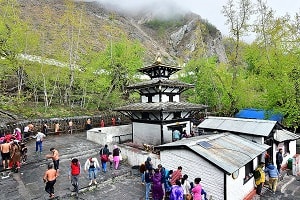 The name of this temple itself intonates the religious tone and also sounds like an emotional ring to its Hindu devout. Seated at an elevation of 3710 meters above the sea level and at the foothills of the Thorong La Pass, Muktinath holds great religious significance in both Hinduism and Buddhism. It is believed to be one of the oldest temples dedicated to Lord Vishnu and it also represents the most ancient Vaishnava tradition in Nepal. The temple is however small but is a highly venerated sacred for Buddhists and Hindus both. Hindus call this place as Mukti Kshetra which means a place to attain salvation whereas Buddhists call it as Chumming Gyatsa which literally means a “hundred waters” in the Tibetan language. Muktinath is considered to be one of the 24 most visited Tantric places and is also a revered place of the goddesses of Dakinis who are also called as sky dancers.
The name of this temple itself intonates the religious tone and also sounds like an emotional ring to its Hindu devout. Seated at an elevation of 3710 meters above the sea level and at the foothills of the Thorong La Pass, Muktinath holds great religious significance in both Hinduism and Buddhism. It is believed to be one of the oldest temples dedicated to Lord Vishnu and it also represents the most ancient Vaishnava tradition in Nepal. The temple is however small but is a highly venerated sacred for Buddhists and Hindus both. Hindus call this place as Mukti Kshetra which means a place to attain salvation whereas Buddhists call it as Chumming Gyatsa which literally means a “hundred waters” in the Tibetan language. Muktinath is considered to be one of the 24 most visited Tantric places and is also a revered place of the goddesses of Dakinis who are also called as sky dancers.
Location
This small yet highly revered temple is located in the Muktinath Valley and at the foothills of the Thorong La Pass which is a part of the Himalayas. Muktinath Temple is nestled at an elevation of 3710 meters above the sea level in Mustang, Nepal. The temple is situated near to Ranipauwa village. The temple is around 90 meter in elevation from Ranipauwa and is around 48 km away from the north east of Jomsom which is a great place to commence trekking. It is located to the north of the Tibetan Plateau and to the south of Annapurna Range.
Architecture
The temple is believed to be constructed in the 19th century and has been designed in Pagoda style. The main temple of Muktinath is dedicated to Lord Vishnu and is shaped like a Pagoda. The statue installed in the shrine is tall like a man and is made up of gold. Statues of Goddess Saraswati, Lakshmi, Garuda, Sapta Rishis, and Luv-Kush are also present inside the temple. It is believed that the central temple of Chumming Gyatsa had risen up itself and is so counted among the eight most sacred temple of Hindu Vaishnavas.
Attractions
- Muktidhara: There are 108 waterspouts which are constructed behind the temple. All these faucets are designed and shaped as bullhead and are arranged very close to each other (barely at a distance of a foot) in a semi-circular form. Pilgrims visiting Muktinath take a dip in every waterspout. However, it requires a lot of courage to take a bath as the waterspouts contain freezing cold water.
- Kunds: There are 2 Kunds established in front of the Muktinath Temple which is named as Saraswati and Lakshmi Kund. Devotees visiting the temple take a dip in these Kunds as they believe that doing this will wash away all their past sins and will set them free from the negative Karmas.
- Jwala Mai Temple: This ancient temple is reckoned for its three eternal flames “Holy flame from Rock”, “Holy flame from the soil”, and “Holy flame from water”. Hindu devout believe that this miracle of continuous burning flame was offered by Lord Brahma. Among these three eternal flames, only two are burning Presently.
- Gomba: A monastery dedicated to Guru Padmasambhava (Rimpoche) housing a huge image of Rimpoche. The monastery is established to the north of the Muktinath Temple and is a must visit the place after completing the puja rituals and prayers at the temple.
- Shaligrama: The other major attraction of Muktinath is Shaligrama which is a black-stoned fossil. It can be collected from the River Gandaki where the fossils of Jurassic Park Age are present. One can also buy these fossils from the locals by paying certain bugs.
- Gomba Samba: It is a newly built monastery where one can find the idols of Chenrezig, Sakyamuni as the main deities. Visiting this beautiful monastery is a worth visit and to add on some more memories to the trip.
Worship and Festivals
The cultural heritage of the temple is in the hands of Buddhist nuns. All the puja rituals performed here are done by the local nuns. As per the temple traditions, devotees after completing their prayers and puja rituals visit Mebar Lha Gomba which is a small monastery famous for miraculous fire. Devout offers Prasad and Shaligram to the deity of Lord Vishnu.
The temple is, however, flocked by devotees throughout the year but on the occasion of Ram Navami, Vijayadashami, and Rishitarpani the temple is heavily crowded with devotees. These festivals are organized in a grand way at Muktinath Temple. So, visiting Muktinath during these festive seasons gives a special experience to the visitors.



 Call
Call WhatsApp
WhatsApp Enquiry
Enquiry